Opportunities and challenges related to a hydrogen-electric fishing vessel
Bachelor thesis
Permanent lenke
https://hdl.handle.net/11250/3002195Utgivelsesdato
2022Metadata
Vis full innførselSamlinger
Sammendrag
Norge er et land med et sterkt forhold til kysten og dens ressurser. Fiskeindustrien bidrar tilinntekt både for mange nordmenn og Norge som land. De fleste fiskefartøy i Norge har i dagdieselfremdrift. På grunn av global oppvarming, luftforurensning og forsuring, må industrien tagrep og redusere utslipp. ZeroKyst-prosjektet ønsker å avkarbonisere sjømatnæringen gjennom enovergang til hydrogenelektrisk fremdrift, samt å demonstrere løsninger for mobil energiforsyningi Lofoten i tillegg til andre delprosjekter. Zerokyst-prosjektet er et forskningssamarbeid mellomindustri, interesseorganisasjoner og kommuner, med Selfa Arctic AS som prosjektleder.Det er mange tekniske og økonomiske utfordringer ved å introdusere ny teknologi. En stor utfordring er at teknologien skal kunne tilby de samme egenskapene som tradisjonell teknologi, itillegg til ˚a være utslippsfri. Hydrogenfremdrift er en umoden teknologi sammenlignet med dieseli maritim sektor. Derfor er regelverket fortsatt under utvikling for optimale hydrogenløsninger.Driftskostnadene for det hydrogenelektriske fiskefartøyet inkluderer hydrogenbunkring og ladingav batteriet. For dieselfartøy inkluderer det kun bunkring av diesel, og med hybrid farttøy målading av batteri også tas i betraktning.Oppgaven tar sikte på å undersøke hvor konkurransedyktig et hydrogenelektrisk fiskefartøy er,sammenlignet med tradisjonell teknologi. En kombinasjon av simulering, kostnadsberegning oglitteraturstudie brukes til vurdere dette. Simuleringene er utført i en modell i Simulink av MATLAB. Resultatene fra simuleringene ble brukt til å forstå energiforbruket til det hydrogenelektriskefiskefartøyet i løpet av fire forskjellige antatte 12-timers driftsprofiler. Kostnadsberegningene visteat per i dag, når fiskerne får dieselkompensasjon er ikke dette konkurransedyktig prismessig. Derimot, i fremtiden vil kompensasjonen sannsynligvis bli fjernet, noe som kan gjøre det lønnsomt åbruke nullutslippsfartøy. Rekkevidden er kortere med et nullutslippsfartøy, og dette kan være tilfredsstillende for noen fiskere. Som sikkerhet vil fartøyet ha en dieselgenerator installert. Fartøyetvil gi et arbeidsmiljø med mindre støy, gitt at det kjører på nullutslippsfremdriftssystemet, og ikkegeneratoren. ZeroKyst-prosjektet utvikler et fiskefartøy med potensial for lavere driftskostnaderog utslipp, men det er viktig at løsningen møter fiskerens behov med tanke på rekkevidde. Norway is a country with a strong relation to the coast and its resources. The fishing industrycontributes as income for both many Norwegians and Norway as a country. Most fishing vesselsin Norway today run on a diesel propulsion system. Due to the global warming, air pollution andacidification, the industry needs to reduce its emissions. The ZeroKyst project want to decarbonizethe seafood industry through a transition to hydrogen-electric propulsion, to demonstrate solutionsfor mobile energy supply in Lofoten in addition to other sub-projects. The Zerokyst project is aresearch collaboration between industry, interest groups and municipalities, with Selfa Arctic ASas project manager.There are many technical and financial challenges which introducing new technology. A majorchallenge is that the technology must be able to offer the same properties as traditional technology,and still be emission-free. Hydrogen propulsion is a immature technology compared to diesel, inthe marine sector. Therefore the regulations are still in development for the optimal hydrogensolutions for vessels. The operating costs for the hydrogen-electric fishing vessel includes bunkeringof hydrogen and charging of the battery. For diesel vessels, it only includes the bunkering of diesel,and with hybrids, charging of battery must also be taken into account.The thesis aims to investigate how competitive is a hydrogen-electric fishing vessel, compared totraditional technology. A combination of simulation, cost calculation and literature study is usedto consider this. The simulations is performed in a model in Simulink by MATLAB. The resultsfrom the simulations was used to understand the energy consumption of a hydrogen-electric fishingvessel during four different 12-hour operating profile. The cost calculations demonstrated that asof today, when the fishers get diesel compensation, this is not competitive price-wise. However,in the future the compensation is likely to be removed, which can make it profitable to use thezero-emission vessel. The range is shorter with a zero-emission vessel, and this might be satisfyingfor some fishers. The vessel will have a diesel generator installed. The vessel will also provide aworking environment with less noise, given that it runs on the zero-emission propulsion system,and not the generator. In conclusion, the ZeroKyst project will develop a fishing vessel with thepotential for lower operating costs and emissions. However, it is important that the solution meetsthe fisher’s need in terms of range.
